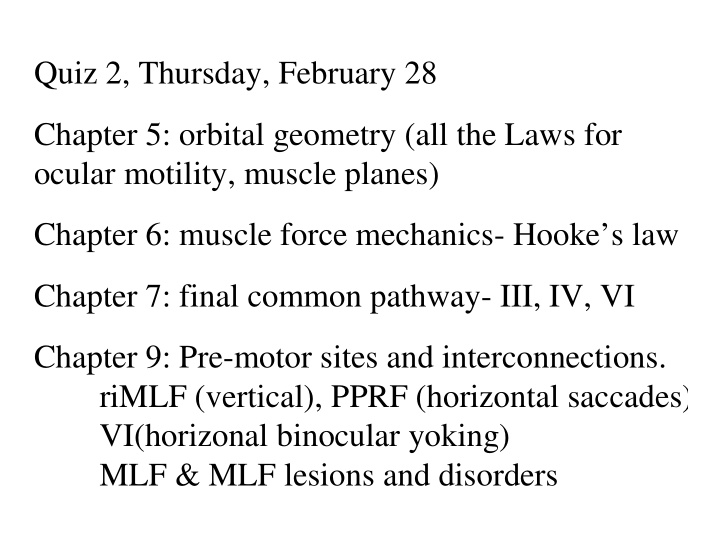



Quiz 2, Thursday, February 28 Chapter 5: orbital geometry (all the Laws for ocular motility, muscle planes) Chapter 6: muscle force mechanics- Hooke’s law Chapter 7: final common pathway- III, IV, VI Chapter 9: Pre-motor sites and interconnections. riMLF (vertical), PPRF (horizontal saccades) VI(horizonal binocular yoking) MLF & MLF lesions and disorders
Vestibular system- the sixth sense Static senses head orientation- Otoliths Dynamic senses head rotation- Canals Evolution of the vestibular system (the sixth sense) from the lateral line of fish. Cochlea (high frequency) Otoliths (low frequency) Canals (mid frequency) Common disorders: Benign Positional Vertigo: Meniere’s syndrome Story about Jack Crawford
VOR holds gaze steady
Vestibular System components
Semicircular Canal detail
Cupula
VOR- 3 synapses bipolar cells Vestibular nuclei Motor neurons III and IV Short latency- 16 msec
Bipolar Cells
Horizontal VOR
Canal planes
Canals & Muscle Planes
Canal-muscle pairings during head rotation LPC LHC LAC RLR, LMR RIO, LSR RIR, LSO LAC LPC RAC LAC RSR, RIO, LSR, LIO RIR, RIO, LSR, LSO
Calcium Carbonate Crystals Otoliths
Benign Positional Vertigo Show Epley Maneuver film
Benign Positional Vertigo Show Epley Maneuver film
Head Posture for Caloric Nystagmus Bedside clinical evaluation of VOR
Caloric Test for Vestibular Function Patient’s head is tilted back 60 degrees so that Horizontal Canal is roughly vertical. Endolymph circulation produces VOR. Fast phase for Cold caloric is toward Opposite ear, for Warm caloric it is toward Same ear. COWS Fast phase --> <--Fast phase Slow phase --> <--Slow phase Warm water Cold water Cold water in the left ear canal makes Warm water in the left ear canal makes endolymph sink and circulate CCW. endolymph rise and circulate CW.
Aviation Otolith illusions The Death spiral- roll illusion While banking to the right the pilot senses a left roll because centripital force Sensed Real stimulates the left urticle left right Compensate by banking plane more to the right to correct attitude. This causes a clockwise descending spiral. The centrifugal force increases the sensation of a left roll and it ends in a big splash.
Ocular Corellas upward pitch illusion During takeoff from the deck of an aircraft carrier, the forward thrust acceleration stimulates Sacculus to sense upward pitch Pilot compensates by pitching the nose down and flies into the ocean in a parabolic flight. Try this out during takeoff on a passenger jet. Notice if you think the nose is up along the isle and compare to the visible horizon seen outside the window.
VOR can be reversed by adaptation Normal VOR After adapting with image reversing goggles In the dark, subject was rotated about 360 degrees first one way, then the other. Arrows show where head rotation changed direction. Stimulus was the same for both traces, but movement was reversed after adaptation. Note the fast phases mixed in with slow phases.
VOR Adaptation
OKN supplements the VOR at low velocities and constant velocities Body sway Constant rotation velocity
OKN Jerk Nystagmus Observed by Purkinje in early 19 th century
Examples of Visual Vestibular interactions Mystery spot- Santa Cruz Otolith-visual conflict- otolith dominates Linear Vection- cinerama, boat docks, stop lights Canal-visual conflict- vision dominates
Active and Passive OKN Eye Position ---> Time ---> Arrows show where Drum changed direction
Cortical and Subcortical OKN Pathways Left side NOT Gets direct subcortical visual input only from Right eye and indirect cortical input from Left eye. Subcortical input drives slow phase to the Left III in both eyes LGN NOT V I DTN V N Ce re b e llu m IO Vis ual Co rt e x
Asymmetric OKN in normal infants and strabismus
Latent Nystagmus
Incidence of Strabismus
Latent Nystagmus
Accessory Optic Tract Nuclei
Infants OKN Pathways
Visual Angles
Angle Lambda (Kappa)
Recommend
More recommend